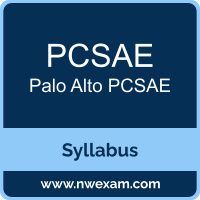 A great way to start the Palo Alto Networks Certified Security Automation Engineer (PCSAE) preparation is to begin by properly appreciating the role that syllabus and study guide play in the Palo Alto PCSAE certification exam. This study guide is an instrument to get you on the same page with Palo Alto and understand the nature of the Palo Alto PCSAE exam.
A great way to start the Palo Alto Networks Certified Security Automation Engineer (PCSAE) preparation is to begin by properly appreciating the role that syllabus and study guide play in the Palo Alto PCSAE certification exam. This study guide is an instrument to get you on the same page with Palo Alto and understand the nature of the Palo Alto PCSAE exam.
Our team of experts has composed this Palo Alto PCSAE exam preparation guide to provide the overview about Palo Alto Security Automation Engineer exam, study material, sample questions, practice exam and ways to interpret the exam objectives to help you assess your readiness for the Palo Alto PCSAE exam by identifying prerequisite areas of knowledge. We recommend you to refer the simulation questions and practice test listed in this guide to determine what type of questions will be asked and the level of difficulty that could be tested in the Palo Alto PCSAE certification exam.
Palo Alto PCSAE Exam Overview:
| Exam Name | Palo Alto Security Automation Engineer |
| Exam Number | PCSAE |
| Exam Price | $175 USD |
| Duration | 90 minutes |
| Number of Questions | 75-85 |
| Passing Score | 860/300 to 1000 |
| Recommended Training | (EDU-380) Cortex XSOAR: Automation and Orchestration |
| Exam Registration | PEARSON VUE |
| Sample Questions | Palo Alto PCSAE Sample Questions |
| Practice Exam | Palo Alto Networks Certified Security Automation Engineer Practice Test |
Palo Alto PCSAE Exam Topics:
| Section | Weight | Objectives |
|---|---|---|
| Playbook Development | 27% |
- Reference and manipulate context data to manage automation workflow - Summarize inputs, outputs, and results for playbook tasks - Configure inputs and outputs for subplaybook tasks - Enable and configure looping on a subplaybook - Differentiate among playbook task types
- Apply filters and transformers to manipulate data |
| Incident Objects | 13% |
- Configure incident types - Identify the role of an incident type within the incident lifecycle - Configure an incident layout
- Summarize the function, capabilities, and purpose of incident fields |
| Automations, Integrations, and Related Concepts | 18% |
- Define the capabilities of automation across XSOAR functions
- Differentiate between automations, commands, and scripts
- Identify the properties and capabilities of the XSOAR framework for integration |
| Content Management and Solution Architecture | 17% |
- Apply marketplace concepts for the management of content
- Apply general content customization and management concepts
- Manage local changes in a remote repository (dev-prod) configuration
- Describe the incident lifecycle within XSOAR
- Identify the troubleshooting tools available to obtain more diagnostic information
- Identify options available for performance tuning
- Monitor system health using the System Diagnostics page |
| UI Workflow, Dashboards, and Reports | 13% |
- Identify methods for querying data
- Summarize the workflow elements used during an investigation
- Interact with layouts for incident management
- Summarize tools used for managing incidents
- Identify the capabilities of existing dashboards and reports |
| Threat Intel Management | 12% |
- Identify the parameters available for configuring indicator Objects
- Generate threat intel reports
- Configure threat intel feed integrations
|
Palo Alto PCSAE Exam Description:
The Palo Alto Networks Security Automation Engineer (PCSAE) certification is designed to validate the knowledge and skills required to develop, analyze, and administer the Palo Alto Networks Cortex XSOAR platform with native threat intelligence management.
